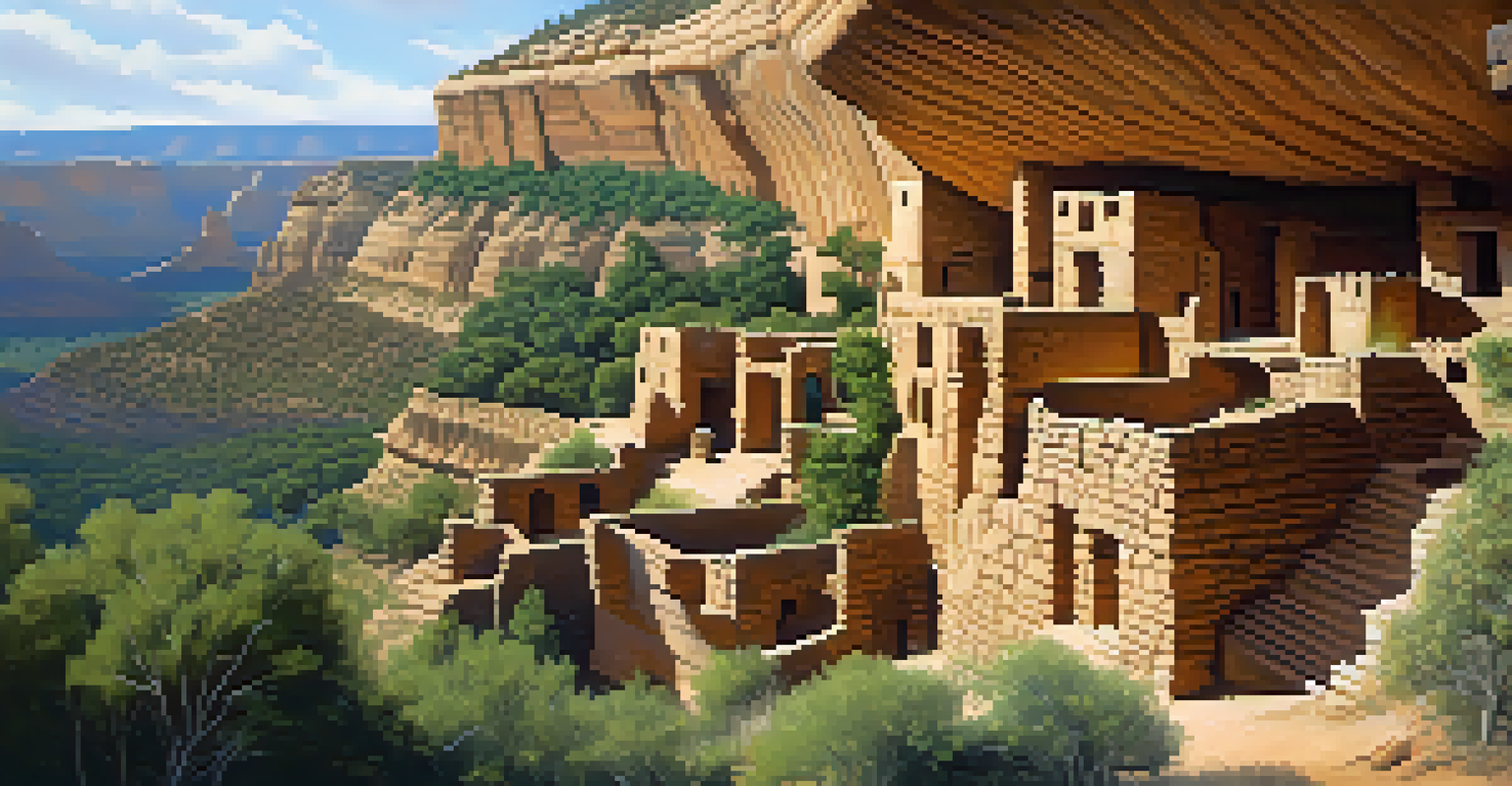Exploring the Ancestral Lands of Colorado's Indigenous Nations

Understanding the Rich History of Colorado's Indigenous Nations
Colorado is home to numerous Indigenous nations, each with a deep-rooted history that predates European settlement. These nations, including the Ute, Cheyenne, and Arapaho, have thrived in diverse environments, from the mountains to the plains. Their rich heritage is woven into the very fabric of Colorado's landscape, making it essential to acknowledge their historical significance.
The land is sacred to the Indigenous peoples, and their relationship with it is woven into their cultural identity.
Many Indigenous communities have maintained their traditions and cultural practices despite colonial impacts. For instance, the Ute people have a profound connection to the land, which is evident in their storytelling and spiritual beliefs. Understanding this history allows us to appreciate the resilience and adaptability of these nations.
Exploring this history not only enriches our knowledge but also fosters respect for the cultural heritage of Colorado’s Indigenous peoples. It’s a reminder that we are all part of a larger narrative, one that encompasses a myriad of voices and experiences.
The Spiritual Connection to the Land
For Colorado’s Indigenous nations, the land is more than just a physical space; it holds spiritual significance. Many tribes view the mountains, rivers, and valleys as sacred, often incorporating them into their creation stories and rituals. This deep connection emphasizes the importance of land stewardship and sustainable practices.

For example, the Ute people believe that the mountains are the home of powerful spirits, which guide and protect them. This belief system not only shapes their cultural identity but also influences their relationship with nature. Such perspectives remind us that our interactions with the environment should be thoughtful and respectful.
Indigenous Nations' Rich Heritage
Colorado's Indigenous nations, such as the Ute, Cheyenne, and Arapaho, possess a profound history that underscores their enduring cultural significance.
By engaging with these spiritual connections, visitors can gain a deeper appreciation for the land's significance. It encourages a more mindful approach to exploring these ancestral territories, fostering a sense of responsibility towards preserving their beauty and integrity.
Cultural Traditions and Practices
The cultural traditions of Colorado’s Indigenous nations are vibrant and diverse, showcasing a rich tapestry of art, music, and storytelling. Each nation has its unique practices, often passed down through generations, reflecting their history and values. For instance, traditional dances and ceremonies play a crucial role in community cohesion and cultural preservation.
Language is the most powerful tool of cultural identity and the key to understanding the world through the eyes of Indigenous peoples.
Craftsmanship is another vital aspect of these cultures, with artisans creating intricate beadwork, pottery, and woven items. These crafts are not just decorative; they hold cultural significance and often tell stories of the people and their relationship with the land. Engaging with these traditions provides insight into the everyday lives of Indigenous communities.
Visitors can participate in cultural events or workshops to experience these traditions firsthand. By doing so, they contribute to the preservation of these practices while fostering a greater understanding of the cultural significance behind them.
The Importance of Language Preservation
Language is a cornerstone of cultural identity, serving as a vessel for stories, traditions, and knowledge. Many Indigenous nations in Colorado are actively working to preserve and revitalize their languages, which are often at risk of disappearing. This effort is essential for maintaining their cultural heritage and fostering community pride.
For instance, the Ute language has seen revitalization efforts through community programs and educational initiatives. These programs not only teach the language but also promote an understanding of cultural values and history. Language revitalization is a powerful tool that empowers communities and strengthens their identity.
Spiritual Connection to the Land
For Indigenous nations, the land is sacred, shaping their cultural identity and emphasizing the importance of sustainable stewardship.
Visitors can support these efforts by learning about the languages and even picking up a few basic words. This small act of respect can go a long way in honoring the rich linguistic heritage of Colorado’s Indigenous nations.
Exploring Historic Sites and Landmarks
Colorado is dotted with historic sites and landmarks that hold significant meaning for Indigenous nations. Sites like Mesa Verde National Park and the Great Sand Dunes offer glimpses into the lives of ancient peoples, showcasing their ingenuity and connection to the land. Visiting these sites provides an opportunity to reflect on the history and heritage of Indigenous cultures.
Guided tours led by Indigenous guides can enrich this experience, offering personal insights and stories that bring the history to life. These guides often share their perspectives on the land and its significance, helping visitors to develop a deeper understanding of the cultural context. Engaging with local knowledge fosters a more respectful and meaningful exploration.
By visiting these historic sites, travelers can support Indigenous tourism and contribute to the economic sustainability of these communities. It’s a way to honor their history while enjoying the breathtaking landscapes of Colorado.
Modern Challenges Faced by Indigenous Nations
Despite their rich heritage, Colorado’s Indigenous nations face modern challenges that threaten their cultural and economic sustainability. Issues such as land rights, environmental degradation, and economic disparities pose significant hurdles. Understanding these challenges is crucial for fostering empathy and support for these communities.
For instance, many tribes are working to reclaim ancestral lands and advocate for environmental protection. They recognize the importance of preserving the land not only for their communities but for future generations as well. This advocacy highlights the interconnectedness of cultural preservation and environmental stewardship.
Challenges and Future Advocacy
Modern challenges like land rights and economic disparities highlight the need for allies to support Indigenous communities in their advocacy efforts.
By educating ourselves about these challenges, we can become allies in supporting Indigenous rights and initiatives. Simple actions, such as supporting Indigenous-owned businesses or participating in advocacy efforts, can make a meaningful impact.
Engaging with Indigenous Communities Respectfully
Engaging with Indigenous communities requires a commitment to respect and understanding. It’s essential to approach these interactions with humility, recognizing the historical context and the ongoing struggles faced by these nations. Seeking permission and guidance from Indigenous leaders is a vital step in fostering respectful relationships.
Participating in community events, workshops, or cultural exchanges can enhance our understanding of their traditions and values. However, it’s important to do so with an open mind and a willingness to listen. Genuine engagement goes beyond mere observation; it involves building relationships based on trust and mutual respect.

By valuing Indigenous voices and stories, we can create a more inclusive narrative that honors their contributions. This approach not only benefits Indigenous communities but enriches our collective understanding of history and culture.
The Future of Colorado's Indigenous Nations
The future of Colorado’s Indigenous nations holds promise as they continue to advocate for their rights and heritage. With a renewed focus on language preservation, cultural revitalization, and environmental stewardship, these communities are redefining their narratives. Their resilience and adaptability serve as a testament to their strength and commitment to future generations.
Collaborative efforts with non-Indigenous allies can further amplify their voices and initiatives. By working together, we can create a supportive environment that values Indigenous perspectives and promotes cultural exchange. This collaboration is essential for building a more equitable future.
As we explore the ancestral lands of Colorado’s Indigenous nations, let us carry forward the lessons of respect, understanding, and appreciation. The journey is not just about discovery; it’s about honoring the past while nurturing a shared future.